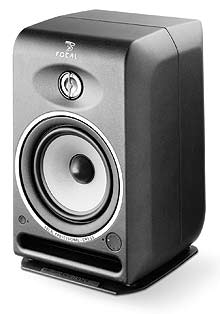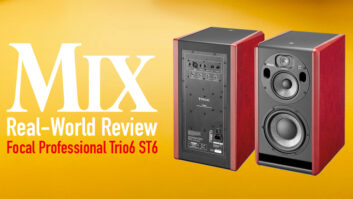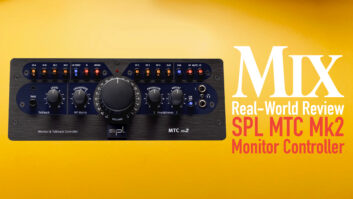
The CMS 65 features a 6.5-inch woofer and 1-inch aluminum/magnesium tweeter.
Focal/JMlab Professional has been producing speaker systems for 20 years and is known for its inverted beryllium-tweeter technology, which is used in the SM6/8/11 speakers. The company’s new CMS (Compact Monitoring System) Series shares a lineage with its beryllium cousins, albeit in the form of less-exotic materials: aluminum and magnesium.
What’s in the Box?
The CMS 65 has a front-ported design and stated frequency range of 45 to 28k Hz. The 6.5-inch Polyglass woofer produces a good amount of punch for a speaker this size, which I attribute to good design techniques in the cabinet, porting and the cone’s rigidity. The tweeter comprises an aluminum/magnesium alloy shaped into an inverted dome. As with all new speakers, the CMS 65s need to be broken in. Focal recommends a minimum of 20 hours. I noticed them smoothing out after about three hours, with an increase in depth and top/bottom clarity, and some midrange “honkiness” beginning to disappear. A mask was pulled away; reverbs and instruments’ upper harmonics became much more apparent, with a greater degree of separation in the soundstage.
Two Class-A/B amps power the CMS 65; one provides 100 watts RMS to the woofer, with the tweeter receiving 60W. Inputs are RCA or balanced XLR. The input sensitivity is not infinitely variable; instead, a three-position pot on the rear panel selects +4dBu/0/-10dBV levels, although a cut-only variable gain adjustment on the speaker front corresponds to a 0 to -66dB range. Also on the front baffle is a Standby switch for muting each speaker individually. This switch is not totally silent as there is a slight pop when you toggle its status from On to Standby and back.
Into the Studio
Other controls on the back of the CMS let you adjust for particular acoustic challenges. A 12dB/octave highpass switch with 45/60/90Hz settings rolls off bass frequencies for use with your favorite subwoofer. LF shelving offers control below 450 Hz, from +2 to -6 dB in 2dB increments. This is particularly useful when using the speakers next to a boundary, cutting the low end to control the bass propagation along a wall. HF shelving has a range of +2 to -4 dB above 4.5 kHz, again letting you tailor the response to your application. The Desktop Notch cuts 160 Hz at 2/4/6 dB with a Q of 2. This is a very handy little filter as I tested these on the bridge of my desk and needed to engage the -2dB position. Pink-noise generation showed this area leveling off when the filter was put in place, avoiding the phase shift associated with this frequency range. Compared to my JBL LSR6328P monitors, the Focal CMS 65 speakers have a slightly forward-sounding midrange. The test signal confirmed a 3dB increase in amplitude, rising from 1.25 kHz and peaking at 2 kHz.
The CMS 65 exhibited a high degree of articulation in the upper range. Pianos, bowed strings and synthesizers were well represented, if not slightly forward in the 1.6 to 2kHz range, as I mentioned previously. Although the specs indicate an upper frequency response out to 28 kHz, the air was not that apparent, with a slight attenuation in the 12kHz range.
I played finished mastered music from many genres through the Focal monitors — including hip-hop, rock ‘n’ roll, alternative, new age, jazz, symphonic and operatic selections — and original 24-bit/96kHz Pro Tools files. The most noticeable differences I heard were in the buzz-saw guitars; the CMS 65s produced a distinctly different timbre as compared to the JBLs, which by comparison felt almost tonally scooped out. During an A/B comparison, the difference in the JBLs’ titanium construction vs. the CMS 65s’ aluminum/magnesium composition was quite evident.
La Musique C’Est Magnifique!
The Focal CMS 65s kept getting better and better the more I played them. Imaging was superb. In many instances, the music was outside the point source of the speaker — much wider than I had anticipated from this little 6.5-inch system. I could easily see these used in a 5.1 arrangement. The slightly forward midrange was reminiscent of — dare I say — a Yamaha NS-10 that actually sounds good. These speakers will be welcome in many different applications, including music production, broadcast, DVD/Blu-ray authoring and game audio. I recommend you give the CMS 65s a good listen — just make sure they’re broken in. I think you’ll like what you hear.
Bobby Frasier is a consultant and engineer.








